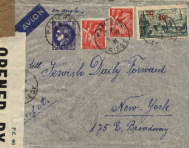Built during the first world war as German prison camp, LE VERNET had been refurbished in February 1939 to shelter Spanish refugees.
They were up to 13,000 in May 1939 but much having been integrated into Companies of Workers, their number fell then.

About October 1939, LE VERNET is transformed into disciplinary camp and becomes the CONCENTRATION CAMP AT LE VERNET D' ARIÈGE - such was its official name - and from the very start November, it accomodated Spanish Republicans and Brigadists coming from the Camp at RIEUCROS as well as foreigners.
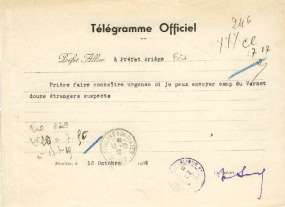
Official Telegramme from the Prefet of Allier dated 13
Octobre 1939,
asking to the Prefet of Ariège whether it is possible to send
twelve suspect foreigners toward the CAMP AT LE VERNET.
Post seal from MOULINS SUR ALLIER dated 13-10-39.

Whereas, at the beginning of October 1939, the number of internees was not any more that of 915, the arrival of German "suspects" and Austrian decrees in PARIS made it go up to more than 1,200 in November.
From November 18, 1939, "suspect" foreign women are transferred to RIEUCROS and are not authorized to take along their children who are entrusted to the Public Assistance.
In her work “The camps of shame”, Anne GRYNBERG gives interesting details about this camp.
Extending on approximately 50 hectares, it was surrounded by three lines of barbed wires. It comprised huts built in boards and covered with tarred paper sheltering two lines of beat-side running along the walls and separated by a narrow passage.
During winter 1939-1940, there was neither heating nor electricity and the internees, having no warm clothing nor covers, slept dressed.
These living conditions involved the appearance of several flu epidemics during this same winter, whereas the “hospital-hut” did not have any suitable equipment.
The internees were divided into three groups in the various districts of
the camp:
Common right: A
Politics: B
Suspects: C
At their arrival, the internees had shaved skull and were stripped their personal objects.
They were permanently under the surveillance of Anti-riot police surveying the camp bayonet with the gun. Subjected to humiliating and useless work, they were under the constant threat of corporal punishments in case of “unwillingness”.
The mail was limited to two letters per week and strictly controlled by the censure.

Lettre from METZ (Moselle) dated 2 Decembre 1939 destinated to an internee
in CAMP AT LE VERNET. Il deals with a "suspect" hosted in quarter C.

|
The lettre has been censured at its departure by the COMMISSION F A of METZ and controled at its arrival at the camp. |
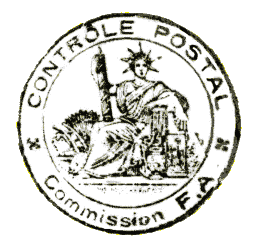
|
In February 1940, there are 2,063 internees including 800 Jews.
150 German and ex-Austrians "enemy”, arrived at the camp in April 1940 and 1050 in May; they preceded another quota by 1800 people, primarily the Italians arrested in PARIS on June 18.
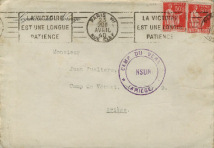
Letter from the LEGATION FROM NORWAY at PARIS, the 23-4-1940,
bound for an internee in the Camp at LE VERNET.
Purple seal of censure.

There will be 3,800 internees in August 1940, of various nationalities.
It is always a repressive camp intended "to the dangerous individuals for the law and order, for taken again justice and the extremists".
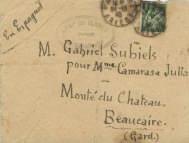
Letter from an internee posted at PAMIERS (Ariège) the 24-10-1940,
bound for BEAUCAIRE (Gard).
Black oval Seal.


It will have to be waited until 1942 so that the installations of the CAMP AT LE VERNET are improved. Six new houses were built in district A and four in the district B.
Regarding the Jews interned in district C - in a deplorable state - their transfer was envisaged in nine new houses which were completed at the end of October 1942.
But, meanwhile, the Jews of district C had been largely deported!
Indeed, during the grim summer 1942, 419 Jews from LE VERNET are transferred to DRANCY, in major part German and Austrian. They will form part of three convoys which will convey them to AUSCHWITZ.
The CAMP AT LE VERNET Of ARIÈGE will close its doors in June 1944, a few days after the deportation of the last internees to DACHAU.

This lettre posted March 1942, the 18th arrived Avril 1942, the 11th.
It was censured by an english commission and controlled at its arrival in
the camp, as indicated by the linear purple mark:
"CONTROLE AU CAMP DU VERNET"
Arthur KOESTLER said about LE VERNET it was “a mixture of ignominie, of corruption, of no interference”.
02/01/2010

